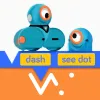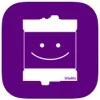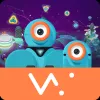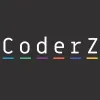Blue-Bot
Simple robot ideal for introducing programming to young learners
Bottom Line: Students will develop logical and sequential thinking with Blue-Bot, creating a foundation for future coding activities.
Blockly for Dash & Dot Robots

Adorable robots teach hands-on coding skills
Bottom Line: You can program robots with code blocks, with plenty of creative options and lots of fun.
Robo Code

Modular robot encourages creativity with endless possibilities
Bottom Line: Robo Code is an interactive, playful way to teach coding and build problem-solving skills in young learners.
The Robot Factory by Tinybop

Improve designs, collect favorites in robot creation sandbox
Bottom Line: A well-made and enjoyable STEM app that leverages what's great about play -- experimentation -- to spark engineering interest.
Evo by Ozobot

Versatile mini robot tailor-made for teaching coding
Bottom Line: Evo encourages students to be creative, emphasizing that coding is a tool in your pocket, not the end game.
Gizmos & Gadgets

Top-notch tool empowers kids to invent, build, and control wirelessly
Bottom Line: Easy-to-use, versatile electronic invention set that works wirelessly with your hand-held device.
SAM Labs
Kids use block code and wireless blocks to program, design, and create
Bottom Line: With some perseverance, it's a great fit for PBL and STEAM, helping students learn programming skills and engineering concepts through invention.
Wonder for Dash and Dot Robots

Serious robotics programming with seriously adorable robots
Bottom Line: It's the most challenging and versatile of the Dash and Dot apps and will keep engineering-savvy kids engaged.
KOOV
Robotics kit makes design possibilities virtually limitless
Bottom Line: For schools with healthy budgets, KOOV helps kids design and code interactive robots with blocks, sensors, and imagination.
Sphero Edu

Cool robots and creative play make programming irresistible
Bottom Line: Hub for Sphero robots draws crafty kids who love making into coding, and it empowers them to be collaborators.
Kai's Clan
Innovative STEAM package takes robot coding to the next level
Bottom Line: A nearly perfect spin on STEAM coding that combines a bunch of technologies into one, and effectively fuses the real and virtual worlds.
Microsoft MakeCode

Bring code to life with circuits, robots, Minecraft, and more
Bottom Line: Once you purchase the hardware, MakeCode opens doors to an incredible diversity of coding applications.
Technovation Families
Family-focused site for learning AI well-suited to classrooms, too
Bottom Line: Makes artificial intelligence and machine learning accessible to students of many ages and abilities.
Cue by Wonder Workshop

Unique robot sports sweet features but isn't classroom-ready yet
Bottom Line: The Cue has great learning potential but needs additional supports to be classroom-friendly.
CoderZ

Program virtual 3D robots to complete missions
Bottom Line: This coding curriculum has great scaffolding for students, but you'll need to find other ways for students to design and create.
Virtual Robotics Toolkit

Supplement your Lego robotics program with solid simulator
Bottom Line: Virtual Robotics Toolkit can up your game by providing useful data as you test code and explore challenges virtually.











